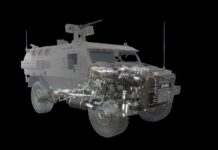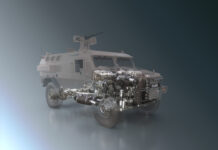Texelis has recently unveiled its ‘Celeris’ 4×4 mobility system concept. Effectively this is a range of kit-based chassis and driveline packages being offered to vehicle manufacturers, in order to simplify the development of new 4×4 platforms. In addition to the chassis and driveline, the Celeris offer also includes Texelis’ assistance with integration of hulls and key vehicle electronic components.
French company Texelis is a mobility systems provider operating in both the commercial and defence sectors. The company’s main commercial activity is in the rail/transport sector, providing axles and driveline systems for metro and tram systems. Their products can be found on metro systems in Paris, Canada, Chile, Mexico and Switzerland. While their tram and automated people mover systems are widely used internationally, it is the defence sector that represents the most important part of Texelis’ business, and it is this sector that is set for significant growth.
In terms of defence, Texelis has participated in a number of major programmes in export markets; for example, the company supplied some 6,000 axles to Mack trucks in support of a Canadian Armed Forces programme to acquire 1,535 trucks. Yugoimport SDPR in Serbia has selected Texelis as the supplier for a range of wheeled armoured vehicle programmes. The Miloš 4×4 multirole tactical vehicle (combat weight 14 tonnes) uses Texelis T700 axles, while the larger Miloš 2 4×4 multirole tactical vehicle (combat weight 18 tonnes) uses T750 axles. Texelis T900 axles and other systems are also used on the Lazar 3 8×8 vehicle and the Lazar 3M 8×8 which is equipped with a 32V01 remote control weapon station (RCWS) mounting a 30 mm 2A42 cannon and a 7.62 mm PKTM (6P7K) machine gun.

The decisive moment for the company’s ambitions in the defence sector came in 2018 when the French defence procurement agency, Direction générale de l’armement (DGA), selected both Texelis and Nexter for the Véhicule Blindé Multi-Rôle Léger (VBMR-L) Serval 4×4 armoured vehicle programme. Serval was acquired under the French Army’s Scorpion programme for a new generation of wheeled armoured vehicles; according to the DGA, there are four main Serval variants: Véhicule de Patrouille Blindée (armoured patrol vehicle), Nœud de Communication Tactique (signals vehicle), Surveillance Acquisition Renseignement et Reconnaissance (surveillance, target acquisition, intelligence and reconnaissance) and Guerre Electronique (electronic warfare).
In February 2017, Texelis and Nexter signed a contract to work together on the Serval programme; Texelis would supply the mobility solution, while Nexter would provide the vehicle body, integrate the two elements and deliver the complete vehicle to the French customer. For Serval, Texelis supplies Nexter with the mobility solution in a number of different kits. These include: an independent suspension system, engine, gearbox, structure for batteries, protected fuel tank, alternator, automatic pre-heating, winch and subframe. First Serval deliveries to the French Army were in 2022, with 978 vehicles due to be acquired by 2035. Under the related Véhicule Léger Tactique Polyvalent Protégé (VLTP-P) programme, an additional 1,060 Servals are due to be acquired.
Moving forwards
The Serval programme provides Texelis with years of long-term production work and an ongoing support business across the more than 30-year lifespan of the vehicle. This solid business base set Texelis to thinking about how they could further develop their position in the global armoured vehicle marketplace. One certainty was immediately obvious; there was an ongoing military demand for protected mobility. In parallel, there was also a demand in many nations to develop a national defence industrial capability in key areas, such as protected mobility. Another aspect was that specialist vehicle developers/manufacturers were also looking to have modern protected mobility solutions that could be applied to military, paramilitary and law enforcement fields.
Developing a wheeled armoured vehicle is a complicated business with high levels of risk involved, as evidenced by the substantial number of underperforming armoured vehicles globally. In the context of a 4×4 armoured vehicle, one possibility to mitigate risk in the development process would be to base the vehicle on a commercial 4×4 chassis. Superficially this is an attractive option; the mobility system is procured and the vehicle body is then developed to meet the operational requirement within the weight constraints of the overall design, allowing a margin for further weight growth. Another attraction of basing a design on a commercial chassis is that it should be more affordable than developing a military specification mobility system.
However, utilising a commercial vehicle chassis as the basis for a 4×4 armoured vehicle actually adds risk to a military vehicle programme. First and foremost, commercial systems are not designed to military specifications. The sort of operational environments and terrain challenges that armoured vehicles are likely to operate within are far more demanding than the relatively benign situations facing commercial vehicles. Though a vehicle manufacturer claims a certain vehicle has a high-level of off-road performance, this does not automatically equate to acceptable performance for a military vehicle.

Credit: Texelis
With a military vehicle, the operator must look at a system in terms of Through Life Capability Management (TLCM), the objective being to keep the vehicle operationally viable and sustainable through its service life, which could mean 30 years or more. The problem with adopting a commercial mobility system is that their product lifecycles are generally much less than 30 years. Another aspect is that commercial manufacturers change and evolve their vehicles through their design lives. This potentially means that the initially contracted mobility solution might not exist a few years later. This adds substantial risk to the long-term supportability of a system.
The other option is to design and develop a complete mobility system as a part of the vehicle design process. This approach is attractive since the vehicle can be designed taking into account a full military TLCM strategy, though more risk is added to the development programme, with the inevitably higher costs associated with this solution.
Taking these issues into account, Texelis concluded that they had the solution to the problem. The Serval programme had proven that they could develop a bespoke full military specification mobility system for a 4×4 armoured vehicle. This would provide the basis for Texelis to develop a range of mobility system solutions for customers looking to develop their own 4×4 armoured vehicles. This would therefore offer the customer reduced risk in developing a vehicle and through working with a contractor that understood TLCM, they would be confident of support throughout the entire service life of the vehicle.
The Celeris solution
The end result is the Celeris system, which Texelis characterises as a turnkey armoured vehicle mobility system. In a 4×4 vehicle application, the Celeris system weighs 4.5 tonnes, which includes tyres, which will support a vehicle with a gross vehicle weight of between 13 and 18 tonnes. The baseline Celeris configuration comes in the form of 12 kits; these contain elements such as axles or powerpack for example. To support the widest possible range of vehicle applications, there are 30 optional kits allowing a potential user to optimise Celeris for their individual operational and performance requirements. Key system elements include a driveline consisting of a Cummins ISL9 Euro 3 diesel engine producing 279.6 kW (375 hp) and an Allison 3200SP automatic transmission – also present are Texelis T750 axles.
Celeris offers countries, or original equipment manufacturers (OEM), a multitude of options to move forward in developing and fielding a 4×4 armoured vehicle. The fact that a flexible set of mobility system options are available means that the development time for a new 4×4 vehicle can be shortened and the level of risk significantly reduced. Additionally, the Celeris system is flexible enough to allow the user to add their own components into the architecture of the system.

(Credit: Texelis)
Another advantage implicit in adopting the Celeris system as an armoured vehicle mobility solution is that Texelis is prepared to work with the customer, assisting with systems integration and design questions through the development of vehicle prototypes and the construction of the initial series of vehicles. In this respect, Texelis becomes a partner in the TLCM process of the vehicle, working together in the design, development, fielding and support of the vehicle throughout its service life. Celeris customers can therefore directly benefit from the practical experience gained by Texelis throughout all stages of the French Army Serval programme.
The current state of play with Celeris is that a launch customer has been selected, though at this stage, the OEM in question remains unspecified for contractual reasons. Texelis is also said to be in discussions with a number of potential clients in both Europe and Asia interested in the Celeris approach. This is particularly true in countries looking to establish their own wheeled armoured vehicle design, development and manufacturing capability.
Allowing an OEM, or country, to mitigate risk in an armoured vehicle programme by adopting a properly defined and supported mobility solution makes sense. For Texelis, the Celeris system will act as the catalyst to transform and grow their defence business in European and international markets. There is more though, the current 4×4 version of Celeris is only a starting point – much more is to come. Texelis is due to unveil further Celeris developments optimised for both 6×6 and 8×8 armoured vehicles. This will open up a potentially massive market for Texelis and could lead to major changes within the international wheeled armoured vehicle marketplace.
David Saw








